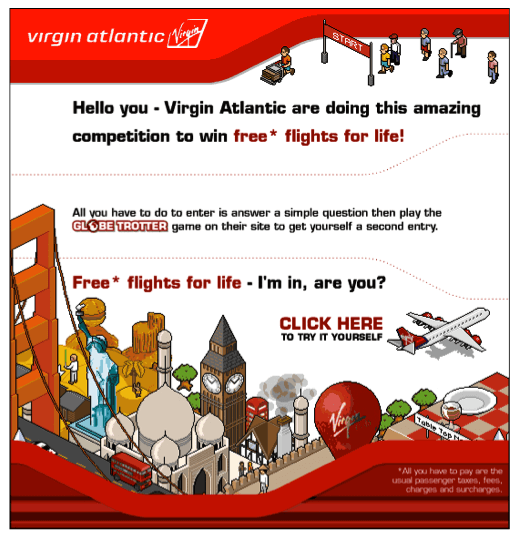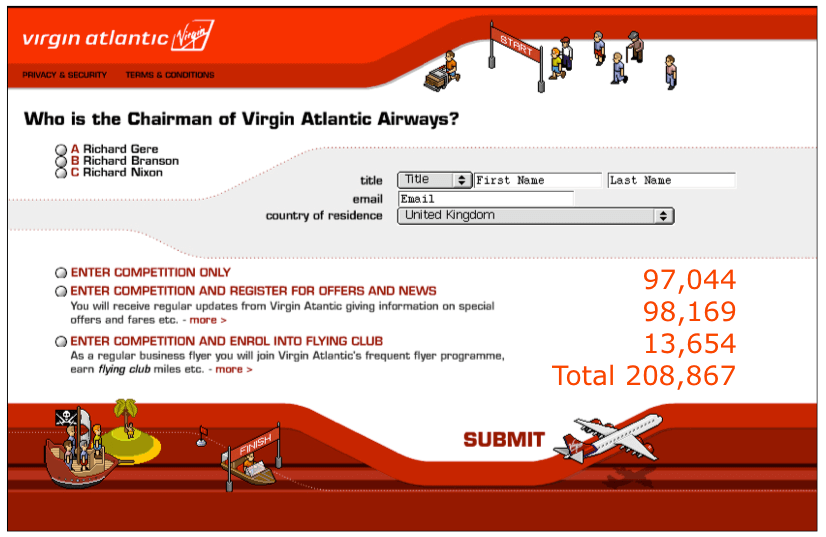A case study of a Virgin Atlantic campaign showing the factors that matter
When marketers discuss email marketing we naturally tend to talk a lot about the creative and certainly it's a great way to learn. I love the inspiring examples at the Retail Email Blog and the Campaign Monitor Gallery. But is it the creative or copy that matters most? Other factors are equally or more important.
To help as a reminder of the email success factors I created the CRITICAL mnemonic which you can apply to just about any digital tactic.
To illustrate CRITICAL, I'm going to use this example of what I think is great email creative. It's not new, in fact I've used it in training for years and it features in the first edition of my Email Marketing book, but not the second. But I thought I'd dust it off for this post - great creative should have a shelf-life:

Background on this email campaign example
This campaign is a little unusual, since it's an acquisition email where the list was sourced from travel magazines and newspaper readers of travel sections. But I think it shows well the power of a great offer with high impact creative to achieve that inbox cut-through we're all looking for.
Virgin Atlantic used a powerful offer of 'Free Flights For Life'. Of 190,000 thousand e-mails sent to rented lists nearly 30% clicked through to find out more about the offer. There was a simple landing page to encourage opt-in and you can see that many did.

The CRITICAL factors for email success
So what does CRITICAL stand for? Can you work it out? Some of the factors that will spring to mind include:
- How well targeted the campaign is to the interests and needs of the recipients - are the e-mails relevant to the audience?
- The offer made to encourage clickthrough to the site.
- You may also have considered the quality of the creative - does it engage the recipient and how well does the copy explain the offer.
The Impact of Digital Beyond Sales and Marketing
My CRITICAL factors are:
- Conversation - Email works best for marketing today when it can prompt a dialogue and encourage social sharing.
- Relevance (including targeting) - Does the offer and creative of the e-mail meet the needs of the recipients? Is a single message sent to all prospects or customers on the list or are e-mails with tailored creative, incentive and copy sent to the different segments on the list? Do recipients think the e-mail is SPAM? Will it get trapped in the Spam filters?
- Incentive (or offer) - The WIFM factor or 'Whats in it for me' for the recipient. What benefits does the recipient gain from clicking on the hyperlink(s) in the e-mail?
- Timing - Timing refers to when the e-mail is received; the time of day, day of the week, point in the month and even the year; how does it relate to events or other campaign elements.
- Integration - Are the e-mail campaigns part of your integrated marketing communications? Questions to ask include: are the creative and copy consistent with my brand? Do the message reinforce other communications? Does the timing of the e-mail campaign fit with offline communications?
- Creative and Copy- This is part of the creative and refers to the structure, style and explanation of the offer together with the number of location of hyperlinks and other calls-to-action in the e-mail.
- Attributes (of the e-mail) - The message headers such as the Subject line, From address and format (HTML or text) have all been written about at length
- Landing page (or microsite) - The page(s) reached after the recipient clicks on a link in the e-mail. Typically, on clickthrough, often the recipient will be presented with a direct response form to profile or learn more about them. Designing the page so the form is easy to complete can effect the overall success of the campaign, but is sometimes neglected.
I have to admit that in the book, the first C was originally Creative, but in the age of social media, Conversation is a nice replacement.
Which of these factors do you think are most important? What am I missing?








